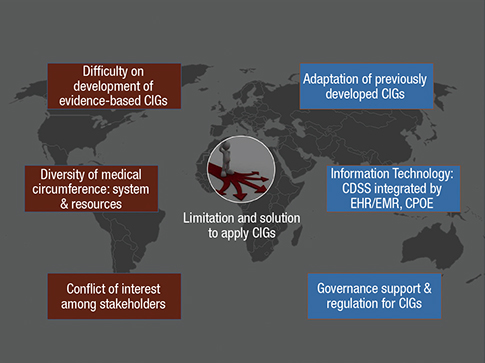J Korean Med Sci.
2016 Feb;31(Suppl 1):S38-S44. 10.3346/jkms.2016.31.S1.S38.
Imaging Guidelines for Enhancing Justifications for Radiologic Studies
- Affiliations
-
- 1Department of Radiology and Center for Imaging Science, Samsung Medical Center, Sungkyunkwan University School of Medicine, Seoul, Korea.
- 2Department of Radiology and the Research Institute of Radiology, University of Ulsan College of Medicine, Asan Medical Center, Seoul, Korea. radbaek@naver.com
- 3Department of Radiology, Seoul St. Mary's Hospital, College of Medicine, The Catholic University of Korea, Seoul, Korea.
- 4Department of Radiology, Korea University Guro Hospital, Korea University College of Medicine, Seoul, Korea.
- 5Division for Healthcare Technology Assessment Research, National Evidence-based Healthcare Collaborating Agency, Seoul, Korea.
- KMID: 2363379
- DOI: http://doi.org/10.3346/jkms.2016.31.S1.S38
Abstract
- Justification in the field of radiology refers to the appropriate use of radiologic imaging modalities, and may be achieved by establishing clinical imaging guidelines (CIGs). Recently, CIGs have been shown to be useful in selecting the proper medical imaging modality, resulting in the reduction of inappropriate radiologic examinations, thereby enhancing justifications. However, the development of CIGs is both time-consuming and difficult as the methodology of evidence-based medicine should be adhered to. Thus, although the radiologic societies in developed countries such as the United Kingdom and USA are already developing and implementing CIGs in their clinical practices, CIGs are not yet readily available in many other countries owing to differences in medical circumstances and resources. In this review, we assess the role and limitations of CIGs by examining the current status of CIGs in developed countries, and also describe the specific efforts made to establish CIGs in Korea.
Keyword
MeSH Terms
Figure
Cited by 1 articles
-
Prospects on the increase of radiological examinations in Korea
Joon-Il Choi
J Korean Med Assoc. 2020;63(3):136-139. doi: 10.5124/jkma.2020.63.3.136.
Reference
-
1. Malone J, Guleria R, Craven C, Horton P, Järvinen H, Mayo J, O’Reilly G, Picano E, Remedios D, Le Heron J, et al. Justification of diagnostic medical exposures: some practical issues. Report of an International Atomic Energy Agency Consultation. Br J Radiol. 2012; 85:523–538.2. International Atomic Energy Agency (IAEA). Report of a consultation on justification of patient exposures in medical imaging. Radiat Prot Dosimetry. 2009; 135:137–144.3. Malone J, O’Connor U, Faulkner K. SENTINEL Project special initiative: ethical and justification issues in medical radiation protection. Radiat Prot Dosimetry. 2009; 135:69–70.4. National Research Council (US) Committee on Health Effects of Exposure to Low Levels of Ionizing Radiations. Health effects of exposure to low levels of ionizing radiations: time for reassessment? Washington, D.C.: National Academy Press;1998.5. International Commission on Radiological Protection. The 2007 Recommendations of the International Commission on Radiological Protection. ICRP publication 103. Ann ICRP. 2007; 37:1–332.6. Medina LS, Blackmore CC. Evidence-based radiology: review and dissemination. Radiology. 2007; 244:331–336.7. Sardanelli F, Hunink MG, Gilbert FJ, Di Leo G, Krestin GP. Evidence-based radiology: why and how? Eur Radiol. 2010; 20:1–15.8. Royal College of Radiologists Working Party. Influence of Royal College of Radiologists’ guidelines on referral from general practice. BMJ. 1993; 306:110–111.9. Eccles M, Steen N, Grimshaw J, Thomas L, McNamee P, Soutter J, Wilsdon J, Matowe L, Needham G, Gilbert F, et al. Effect of audit and feedback, and reminder messages on primary-care radiology referrals: a randomised trial. Lancet. 2001; 357:1406–1409.10. Oakeshott P, Kerry SM, Williams JE. Randomized controlled trial of the effect of the Royal College of Radiologists’ guidelines on general practitioners’ referrals for radiographic examination. Br J Gen Pract. 1994; 44:197–200.11. Hsu J, Brożek JL, Terracciano L, Kreis J, Compalati E, Stein AT, Fiocchi A, Schünemann HJ. Application of GRADE: making evidence-based recommendations about diagnostic tests in clinical practice guidelines. Implement Sci. 2011; 6:62.12. Gopalakrishna G, Mustafa RA, Davenport C, Scholten RJ, Hyde C, Brozek J, Schünemann HJ, Bossuyt PM, Leeflang MM, Langendam MW. Applying Grading of Recommendations Assessment, Development and Evaluation (GRADE) to diagnostic tests was challenging but doable. J Clin Epidemiol. 2014; 67:760–768.13. Royal College of Radiologists. iRefer: making the best use of clinical radiology. 2012. accessed on 3 June 2015. Available at https://www.rcr.ac.uk/irefer-making-best-use-clinical-radiology.14. Oxford Centre for Evidence-based Medicine.Oxford Centre for evidence-based medicine - levels of evidence (March 2009). accessed on 17 June 2015. Available at http://www.cebm.net/oxford-centre-evidence-based-medicine-levels-evidence-march-2009/.15. American College of Radiology. ACR Appropriateness criteria®. accessed on 3 June 2015. Available at http://www.acr.org/Quality-Safety/Appropriateness-Criteria.16. American College of Radiology. ACR Appropriateness Criteria®: overview. accessed on 8 June 2015. Available at http://www.acr.org/~/media/ACR/Documents/AppCriteria/Overview.pdf.17. National Decision Support Company. ACR select. Your rules. Your value. accessed on 8 June 2015. Available at http://www.acrselect.org/downloads/productsheet/ACRselect_value-based_imaging.pdf.18. Moriarity AK, Klochko C, O’Brien M, Halabi S. The effect of clinical decision support for advanced inpatient imaging. J Am Coll Radiol. 2015; 12:358–363.19. European Society of Radiology. ESR EuroSafe imaging-together for patient safety. accessed on 10 June 2015. Available at http://www.myesr.org/cms/website.php?id=/en/eu_affairs/esr_eurosafe_imaging_campaign.htm.20. Remedios D, Hierath M, Ashford N, Bezzi M, Cavanagh P, Chateil JF, Grenier P, Simeonov G, Vilgrain V. Imaging referral guidelines in Europe: now and in the future-EC Referral Guidelines Workshop Proceedings. Insights Imaging. 2014; 5:9–13.21. Malone J, del Rosario-Perez M, Van Bladel L, Jung SE, Holmberg O, Bettmann MA. Clinical imaging guidelines part 2: Risks, benefits, barriers, and solutions. J Am Coll Radiol. 2015; 12:158–165.22. Health Insurance Review and Assessment Service. The assessment about test application of the guideline for repeated CT and MRI examinations. accessed on 17 June 2015. Available at http://www.hira.or.kr/rc/icenter/study/getReportInfo.do?pgmid=HIRAA030095000000.23. Kassing P, Duszak R. Repeat medical imaging: a classification system for meaningful policy analysis and research. Reston, VA: Harvey L. Neiman Health Policy Institute;2013. p. 1–7.
- Full Text Links
- Actions
-
Cited
- CITED
-
- Close
- Share
- Similar articles
-
- Radiologic Findings of Primary Mucinous Cystadenocarcinoma of the Breast: A Report of Two Cases and a Literature Review
- Performance of ChatGPT, Bard, Claude, and Bing on the Peruvian National Licensing Medical Examination: a cross-sectional study
- Specification of Subject Sex in Oncology-Related Animal Studies
- Non-enhancing gliomas: does intraoperative ultrasonography improve resections?
- Enhancing Solid Component within Mature Ovarian Teratomas on MR: Does it Indicate a Malignant Transformation?



